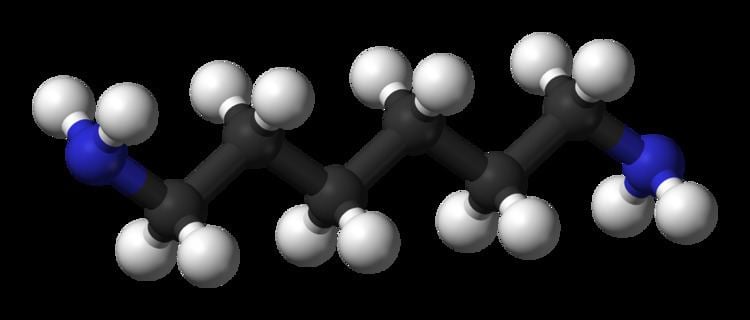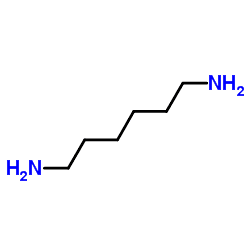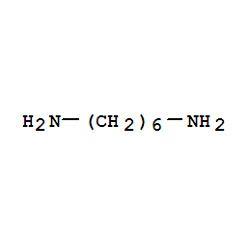Formula C6H16N2 Density 840 kg/m³ | Molar mass 116.21 g/mol Appearance Colourless crystals | |
Related alkanamines | ||
Hexamethylenediamine
Hexamethylenediamine is the organic compound with the formula H2N(CH2)6NH2. The molecule is a diamine, consisting of a hexamethylene hydrocarbon chain terminated with amine functional groups. The colorless solid (yellowish for some commercial samples) has a strong amine odor, similar to piperidine. About 1 billion kilograms are produced annually.
Contents

Synthesis
Hexamethylenediamine was first reported by Theodor Curtius. It is produced by the hydrogenation of adiponitrile:
NC(CH2)4CN + 4 H2 → H2N(CH2)6NH2
The hydrogenation is conducted on molten adiponitrile diluted with ammonia, typical catalysts being based on cobalt and iron. The yield is good, but commercially significant side products are generated by virtue of reactivity of partially hydrogenated intermediates. These other products include 1,2-diaminocyclohexane, hexamethyleneimine, and the triamine bis(hexamethylenetriamine).

An alternative process uses Raney nickel as the catalyst and adiponitrile that is diluted with hexamethylenediamine itself (as the solvent). This process operates without ammonia and at lower pressure and temperature.
Applications

Hexamethylenediamine is used almost exclusively for the production of polymers, an application that takes advantage of its bifunctional structure. The great majority of the diamine is consumed by the production of nylon 66 via condensation with adipic acid. Otherwise hexamethylene diisocyanate (HDI) is generated from this diamine as a monomer feedstock in the production of polyurethane. The diamine also serves as a cross-linking agent in epoxy resins.
Safety
Hexamethylenediamine is moderately toxic, with LD50 of 792-1127 mg/kg. Nonetheless, like other basic amines, it can cause serious burns and severe irritation. Such injuries were observed in the accident at the BASF site in Seal Sands, near Billingham (UK) on 4 January, 2007 in which 37 persons were injured, one of them seriously.
Stability
Hexamethylenediamine is stable in air but combustible. It is incompatible with strong oxidants.
